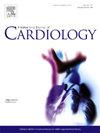Sjögren's syndrome and pulmonary hypertension: Exploring the intricate link with interstitial lung disease
IF 3.2
2区 医学
Q2 CARDIAC & CARDIOVASCULAR SYSTEMS
引用次数: 0
Abstract
Background
Primary Sjögren's syndrome (pSS) is a systemic autoimmune disease commonly presenting with sicca symptoms and, in approximately one-third of cases, extra-glandular manifestations, including pulmonary involvement. Pulmonary hypertension (pH) is a recognized, though less frequently studied, complication in pSS, particularly in patients with interstitial lung disease (ILD). This study evaluates the prevalence of PH in pSS and the relationship between ILD and cardiovascular risk in this population.
Methods
This cross-sectional study included 63 patients with pSS, diagnosed according to ACR/EULAR criteria. Among them, 24 patients (38.1 %) had ILD, with 9 presenting pulmonary fibrosis. Comprehensive evaluations were conducted, including 2D/3D echocardiography, HRCT, and pulmonary function tests. Right heart catheterization confirmed PH when indicated. Patients were categorized into pSS-ILD and pSS-noILD groups for comparative analysis.
Results
The cohort comprised 7 males (11.1 %) and 56 females (88.9 %), with a mean age of 69.1 ± 12.5 years. The prevalence of PH was low (1.6 %), with only one confirmed case via right heart catheterization, significantly below previous reports. Notably, pSS-ILD patients were older (77.1 ± 10.7 years) and diagnosed with pSS later (68.5 ± 12.6 years; p = 0.001) than pSS-noILD patients. Cardiovascular comorbidities, including arterial hypertension (32.8 %) and dyslipidemia (24.2 %), were more prevalent in pSS-ILD patients (p = 0.003 and p = 0.001, respectively). Pulmonary function tests revealed lower FVC (2.23 ± 0.70 vs. 2.98 ± 0.56; p = 0.004) and DLCO-Sb (3.87 ± 1.52 vs. 5.31 ± 1.26; p = 0.017) in pSS-ILD patients, indicating reduced lung function. Echocardiographic findings showed higher sPAP values (>35 mmHg) and reduced TAPSE/sPAP ratios in the pSS-ILD group (p = 0.028 and p = 0.026, respectively), suggesting early signs of right ventricular impairment.
Conclusions
PH prevalence in pSS is lower than previously reported, likely due to rigorous diagnostic criteria. Patients with pSS-ILD exhibit a higher risk of cardiovascular comorbidities and lung function decline. Echocardiographic monitoring of parameters like TAPSE/sPAP may aid in early PH detection, emphasizing the need for tailored management in pSS-ILD patients. Further studies are warranted to explore PH subtypes in diverse populations and to optimize follow-up protocols for at-risk patients.
Sjögren综合征和肺动脉高压:探索与间质性肺疾病的复杂联系
原发性Sjögren综合征(pSS)是一种全身性自身免疫性疾病,通常表现为干燥症状,大约三分之一的病例有腺外表现,包括肺部受累。肺动脉高压(pH)是公认的pSS并发症,但研究较少,特别是在间质性肺疾病(ILD)患者中。本研究评估了pSS患者PH的患病率以及ILD与心血管风险之间的关系。方法本横断面研究纳入63例经ACR/EULAR诊断的pSS患者。其中24例(38.1%)发生ILD, 9例表现为肺纤维化。进行综合评价,包括二维/三维超声心动图、HRCT和肺功能检查。右心导管检查证实PH值。将患者分为pSS-ILD组和pSS-noILD组进行比较分析。结果男性7例(11.1%),女性56例(88.9%),平均年龄69.1±12.5岁。PH的患病率很低(1.6%),只有1例通过右心导管确诊,明显低于以前的报道。值得注意的是,pSS- ild患者年龄较大(77.1±10.7岁),诊断为pSS的时间较晚(68.5±12.6岁);p = 0.001)高于pSS-noILD患者。心血管合并症,包括动脉高血压(32.8%)和血脂异常(24.2%),在pSS-ILD患者中更为普遍(分别为p = 0.003和p = 0.001)。肺功能检查显示FVC降低(2.23±0.70 vs. 2.98±0.56;p = 0.004)和DLCO-Sb(3.87±1.52和5.31±1.26;p = 0.017),表明肺功能降低。超声心动图显示pSS-ILD组sPAP值升高(35 mmHg), TAPSE/sPAP比值降低(p = 0.028和p = 0.026),提示右室损伤的早期迹象。结论pSS患者sph患病率低于既往报道,可能与严格的诊断标准有关。pSS-ILD患者出现心血管合并症和肺功能下降的风险更高。超声心动图监测参数如TAPSE/sPAP可能有助于早期PH检测,强调pSS-ILD患者需要量身定制的管理。需要进一步的研究来探索不同人群中的PH亚型,并优化高危患者的随访方案。
本文章由计算机程序翻译,如有差异,请以英文原文为准。
求助全文
约1分钟内获得全文
求助全文
来源期刊

International journal of cardiology
医学-心血管系统
CiteScore
6.80
自引率
5.70%
发文量
758
审稿时长
44 days
期刊介绍:
The International Journal of Cardiology is devoted to cardiology in the broadest sense. Both basic research and clinical papers can be submitted. The journal serves the interest of both practicing clinicians and researchers.
In addition to original papers, we are launching a range of new manuscript types, including Consensus and Position Papers, Systematic Reviews, Meta-analyses, and Short communications. Case reports are no longer acceptable. Controversial techniques, issues on health policy and social medicine are discussed and serve as useful tools for encouraging debate.
 求助内容:
求助内容: 应助结果提醒方式:
应助结果提醒方式:


